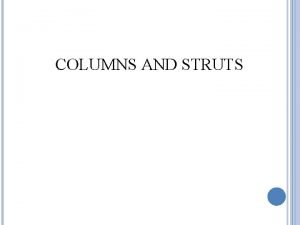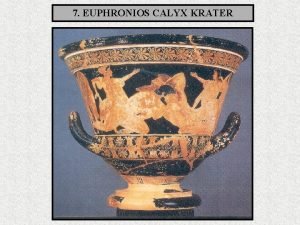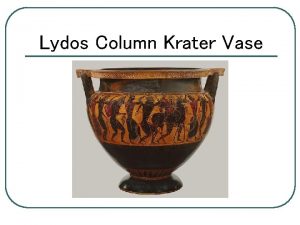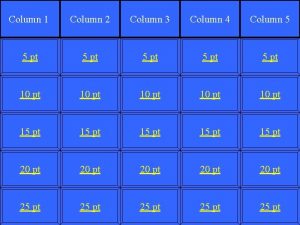2 THE LYDOS COLUMN KRATER Date 550 40














- Slides: 14

2. THE LYDOS COLUMN KRATER

Date: 550 -40 BC Type: Column Krater-Black figure Potter: Unknown Painter: Lydos (not signed but his through style) Height: 56. 5 cm Subject: Return of Hephaistos from Mt. Etna to Olympus, accompanied by Dionysus. Before we begin, consider these questions: • What was a krater was used for by the Greeks? • Why might this illustration have been in any way appropriate?

Some Extra Information *How do we know who it is, since the characters aren't named in the same way they were on the Francois Vase? Easy. Dionysus is always portrayed as a bearded, gowned man carrying a vine prop, and wearing a wreath of some sort. He is also always accompanied by satyrs (the ones with tails) and maenads (the ones without tails, but accompanying satyrs!). Since the most famous piece of accompanying that he did was with Hephaistos, and the other character looks regal and is well adorned, who else could it be ? Convinced ? Neither am I, but it's right!!

The Painter An immigrant from Lydia in Asia Minor (hence Lydos), but learnt his trade in Athens. High quality, but stylistically very similar to other vases, suggesting that he was a member of a larger workshop. In other vases he painted the decoration was purely animal, unlike this one which is devoted to myth. Figures are much larger and more elaborate than those of Kleitias, but still very much the same in their style (figures up to 25 cm high). Lydos painted both large and small pieces. His satyrs are not sexually active or rough, note the flaccid penises compared with those of the lower belly of the Francois Vase. There are generally fewer incised details than in Kleitias' work with the exception of the stippling that creates the effect of hair on the satyrs, and the traces of white that remain on the maenads. There is some very impressive incision work on the hems of the maenads.

Subject Matter Same as the reverse belly of the Francois Vase, the return of Hephaistos from Mt. Etna to Mt. Olympus, led by Dionysus. They are accompanied by satyrs (the ones with the tails) and maenads (the females wearing clothes and not tails). One side depicts one figure, the other side, the other figure. Hephaistos is the character riding on a donkey, while Dionysus is walking. Note the satyrs holding snakes, and another sneaking a drink from the top of a wine skin, and pulling the tail of the satyr in front, a mood of fun.

Composition This is the way that the whole vase is put together with its various elements. The main tableau is bordered above by alternating red and black tongues, that vary in size around the vase. This is probably not deliberate, and shows that the artist was not perhaps as impressive as he might appear in the first instance. It is bordered below by thinnish red bands. The vase itself is large, especially in its girth, and would certainly have taken two slaves to lift. Almost all the figures look to the right, as you look at the vase, but there are ten exceptions out of the 27 figures: i) Satyr to the immediate left of Hephaistos, who is FF (wearing a mask). ii) Satyr two to the left of Dionysus, who is FF iii) Satyr four to the right of Dionysus (head only) iv) Satyr seven to the right of Dionysus (head only) v) The group of satyrs and maenads to the right of Hephaistos includes six figures facing to the left (including the small one under the handles: some are heads only). The main frieze goes right around the vase.






Composition cont. The other figures on the vase are along the rim of the vase. Here we can see bulls, boars, panthers, deer and lions engaged in tussles. Above the handles are gorgoneions, they are flanked by cranes and are virtually identical.

Technique and Style Standard Black figure pot with the white to indicate women, this was quite standard. The coral red slip has been used for tongues, the clothes of some of the maenads, the wine sacks and Dionysus' robe. The clothing portrayed is heavy and foldless, except the end of Dionysus' cloak which has some large rudimentary folds. There is overlapping present, but no real illusion of depth, despite this. The forward looking trends that are present here are: a) Freer movement of large scale figures b) Attempts to capture emotion c) Beginning of folds in Dionysus' drapery d) Mood suggested by lively foot movements and raised hands e) Space - simple overlapping still used

Developments and differences between the Francois Vase and the Lydos, Column Krater • Theme / subject runs continuously round the whole vase • Liveliness conveyed through movement and gesture • Freer movement of large-scale figure • Variety of gestures links the characters more successfully than on the Francois Vase • Some attempts to convey expressions • Folds beginning to appear at the ends of drapery to suggest volume
 Euler formula for column
Euler formula for column Dividend payment
Dividend payment Dividend eligibility
Dividend eligibility Nymarxism
Nymarxism Kaynak hatalari
Kaynak hatalari Berlin painter volute krater
Berlin painter volute krater Interproksimal krater
Interproksimal krater Največji meteoritski krater
Največji meteoritski krater Yucatansky krater
Yucatansky krater Patom krater
Patom krater Euphronios calyx krater
Euphronios calyx krater Niobid painter calyx krater
Niobid painter calyx krater Bell krater by mcdaniel painter, “cheiron vase”
Bell krater by mcdaniel painter, “cheiron vase” Parazitický sopouch
Parazitický sopouch Toner sklonovanie
Toner sklonovanie

























